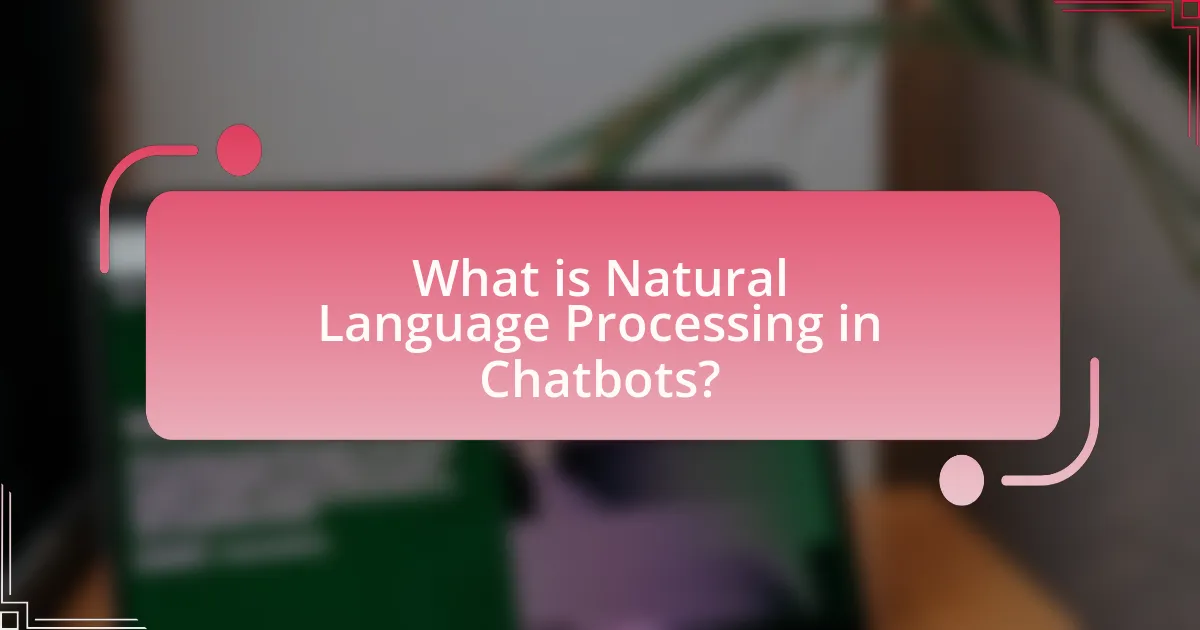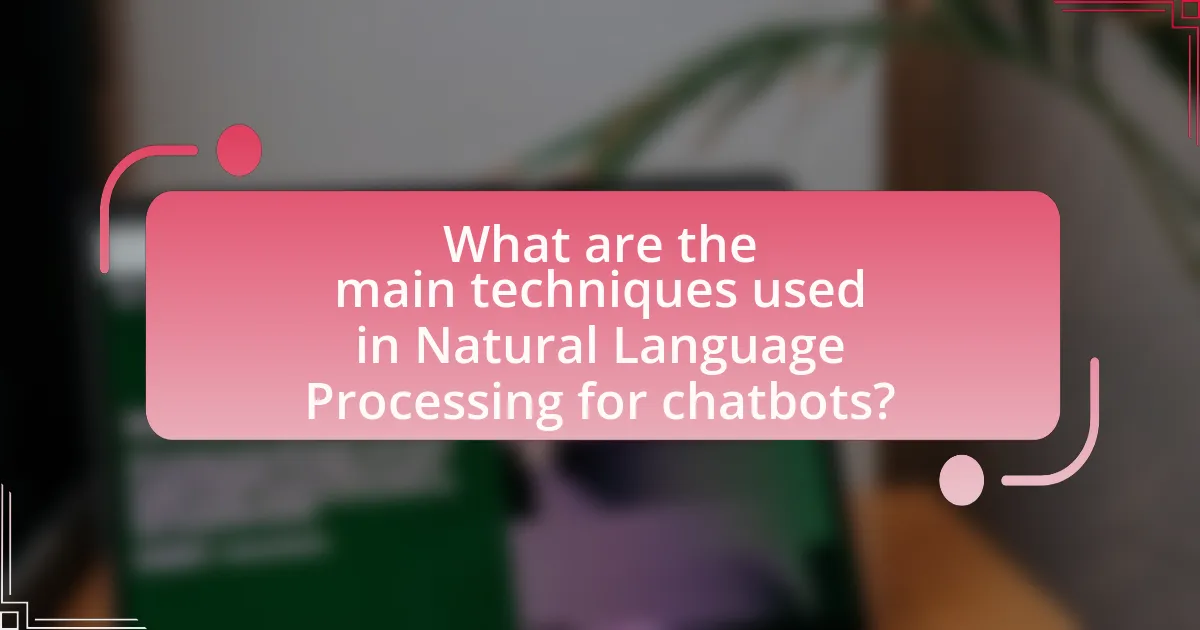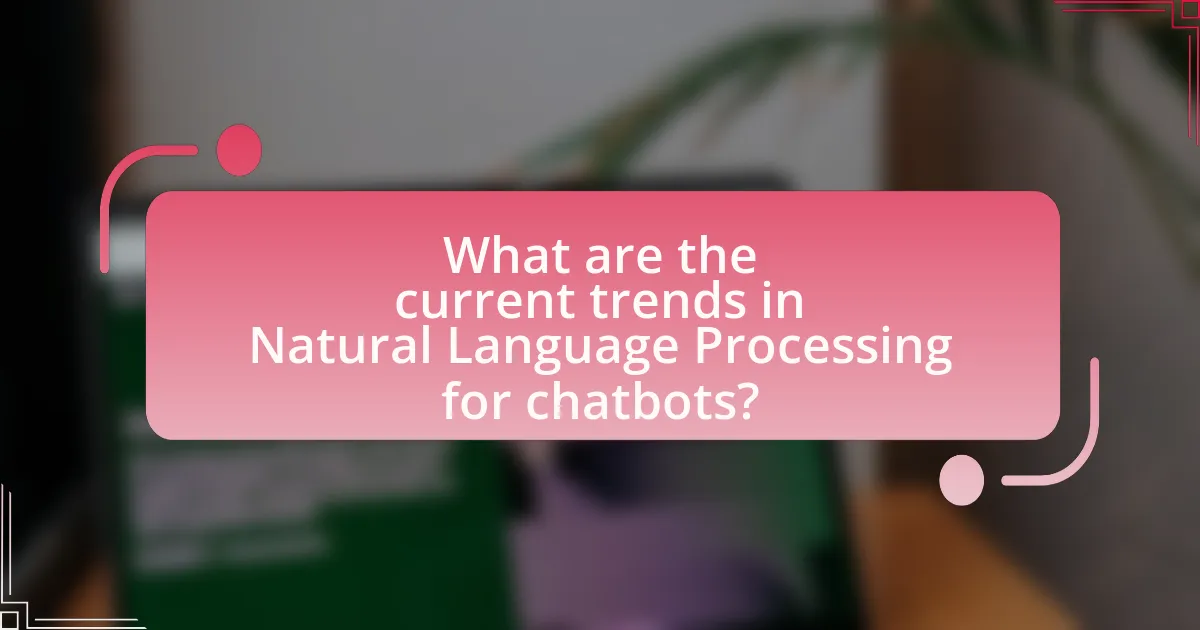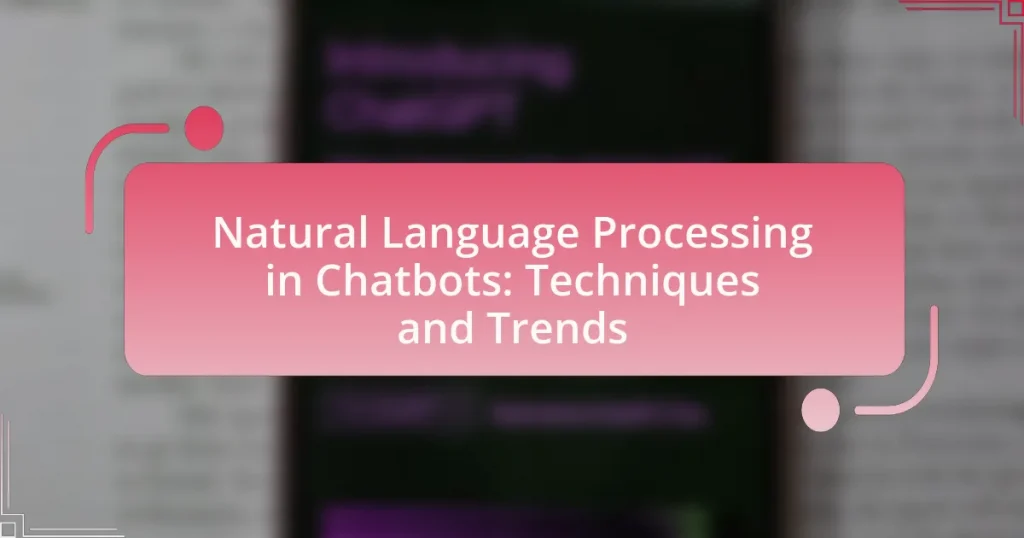Natural Language Processing (NLP) is a critical technology that enables chatbots to understand, interpret, and respond to human language effectively. This article explores the various techniques and components of NLP, such as tokenization, sentiment analysis, and intent recognition, which enhance chatbot functionality and user experience. It also discusses the role of machine learning algorithms in improving chatbot responses, the importance of sentiment analysis in fostering engagement, and current trends shaping the future of chatbot interactions. Additionally, the article highlights best practices for developers to ensure effective implementation of NLP in chatbots, addressing common pitfalls to avoid during development.

What is Natural Language Processing in Chatbots?
Natural Language Processing (NLP) in chatbots refers to the technology that enables these systems to understand, interpret, and respond to human language in a meaningful way. NLP allows chatbots to analyze user input, extract relevant information, and generate appropriate responses, facilitating effective communication between humans and machines. For instance, NLP techniques such as tokenization, sentiment analysis, and named entity recognition are commonly employed to enhance the chatbot’s ability to comprehend context and intent, thereby improving user experience and engagement.
How does Natural Language Processing enhance chatbot functionality?
Natural Language Processing (NLP) enhances chatbot functionality by enabling them to understand and generate human language more effectively. This capability allows chatbots to interpret user queries accurately, respond contextually, and engage in more natural conversations. For instance, NLP techniques such as sentiment analysis and entity recognition help chatbots discern user intent and emotional tone, leading to more personalized interactions. Research indicates that chatbots utilizing NLP can achieve up to 90% accuracy in understanding user inputs, significantly improving user satisfaction and engagement.
What are the key components of Natural Language Processing in chatbots?
The key components of Natural Language Processing in chatbots include tokenization, part-of-speech tagging, named entity recognition, sentiment analysis, and intent recognition. Tokenization breaks down text into individual words or phrases, allowing for easier analysis. Part-of-speech tagging assigns grammatical categories to words, aiding in understanding sentence structure. Named entity recognition identifies and classifies key elements in text, such as names and locations, which is crucial for context. Sentiment analysis evaluates the emotional tone behind words, helping chatbots respond appropriately to user emotions. Intent recognition determines the user’s purpose, enabling the chatbot to provide relevant responses. These components work together to enhance the chatbot’s ability to understand and generate human-like responses.
How do these components interact to improve user experience?
Natural Language Processing (NLP) components, such as intent recognition, entity extraction, and context management, interact to enhance user experience by enabling chatbots to understand and respond accurately to user queries. Intent recognition identifies the user’s purpose, allowing the chatbot to provide relevant responses. Entity extraction captures specific details from user input, ensuring that the chatbot can tailor its replies based on context. Context management maintains the flow of conversation, allowing for more natural interactions. Together, these components create a seamless dialogue, reducing misunderstandings and improving user satisfaction. Studies show that effective NLP implementations can increase user engagement by up to 50%, demonstrating the significant impact of these interactions on user experience.
Why is Natural Language Processing important for chatbots?
Natural Language Processing (NLP) is crucial for chatbots because it enables them to understand and generate human language effectively. This understanding allows chatbots to interpret user queries accurately, facilitating meaningful interactions. For instance, NLP techniques such as tokenization, sentiment analysis, and named entity recognition enhance a chatbot’s ability to comprehend context and intent, leading to more relevant responses. According to a study by McKinsey, companies that effectively utilize NLP in customer interactions can improve customer satisfaction by up to 20%. This demonstrates that NLP not only enhances communication but also drives business value through improved user experiences.
What challenges do chatbots face without Natural Language Processing?
Chatbots without Natural Language Processing face significant challenges in understanding and interpreting user input. These chatbots struggle with accurately recognizing user intent, leading to miscommunication and ineffective responses. For instance, without NLP, a chatbot cannot differentiate between similar phrases or understand context, resulting in a rigid interaction model that fails to accommodate the nuances of human language. This limitation can lead to user frustration and decreased engagement, as users may feel their queries are not being understood or addressed appropriately. Furthermore, the inability to process natural language restricts chatbots to predefined scripts, severely limiting their adaptability and effectiveness in dynamic conversational scenarios.
How does Natural Language Processing contribute to better communication?
Natural Language Processing (NLP) enhances communication by enabling machines to understand, interpret, and respond to human language in a meaningful way. This capability allows for more natural interactions between users and chatbots, facilitating clearer and more efficient exchanges of information. For instance, NLP techniques such as sentiment analysis and entity recognition help chatbots discern user intent and emotional tone, leading to more personalized and contextually relevant responses. Research indicates that chatbots utilizing NLP can improve user satisfaction by up to 70%, demonstrating the effectiveness of these technologies in fostering better communication.

What are the main techniques used in Natural Language Processing for chatbots?
The main techniques used in Natural Language Processing for chatbots include intent recognition, entity extraction, natural language understanding (NLU), and response generation. Intent recognition allows chatbots to identify the user’s purpose behind a query, while entity extraction identifies specific data points within the text, such as names or dates. Natural language understanding (NLU) processes the user’s input to derive meaning and context, enabling more accurate interactions. Response generation techniques, such as rule-based systems or machine learning models, create appropriate replies based on the processed input. These techniques are essential for enhancing user experience and ensuring effective communication in chatbot applications.
How do machine learning algorithms apply to Natural Language Processing in chatbots?
Machine learning algorithms enhance Natural Language Processing (NLP) in chatbots by enabling them to understand, interpret, and generate human language effectively. These algorithms, such as supervised learning, unsupervised learning, and reinforcement learning, allow chatbots to learn from vast datasets, improving their ability to recognize patterns in user input and respond appropriately. For instance, supervised learning models can be trained on labeled datasets to classify intents and extract entities, while unsupervised learning techniques can identify topics and sentiments in conversations. Reinforcement learning further optimizes chatbot responses by rewarding successful interactions, leading to continuous improvement in user engagement. The application of these machine learning algorithms is evidenced by the widespread use of models like BERT and GPT, which have significantly advanced the capabilities of chatbots in understanding context and generating coherent responses.
What types of machine learning models are commonly used?
Commonly used machine learning models include supervised learning models, unsupervised learning models, and reinforcement learning models. Supervised learning models, such as linear regression and support vector machines, are utilized for tasks where labeled data is available, enabling predictions based on input-output pairs. Unsupervised learning models, like k-means clustering and principal component analysis, are employed to identify patterns in data without labeled outcomes. Reinforcement learning models, including Q-learning and deep Q-networks, focus on learning optimal actions through trial and error in dynamic environments. These models are foundational in various applications, including natural language processing in chatbots, where they enhance understanding and response generation.
How do these models improve chatbot responses?
These models improve chatbot responses by enhancing understanding of context and intent in user queries. Advanced natural language processing techniques, such as transformer architectures, enable chatbots to analyze and generate human-like responses by considering the nuances of language, including syntax and semantics. For instance, models like GPT-3 have been shown to significantly increase the relevance and coherence of responses, as evidenced by their ability to maintain context over longer conversations and generate contextually appropriate replies. This improvement leads to more engaging and effective interactions, ultimately enhancing user satisfaction and trust in chatbot systems.
What role does sentiment analysis play in chatbot interactions?
Sentiment analysis plays a crucial role in chatbot interactions by enabling the chatbot to understand and respond to user emotions effectively. This understanding allows chatbots to tailor their responses based on the user’s emotional state, enhancing user satisfaction and engagement. For instance, a study published in the Journal of Artificial Intelligence Research indicates that chatbots utilizing sentiment analysis can improve user experience by 30% compared to those that do not. By accurately interpreting sentiments, chatbots can provide empathetic responses, escalate issues when users express frustration, or maintain a friendly tone when users are positive, thereby fostering a more human-like interaction.
How can sentiment analysis enhance user engagement?
Sentiment analysis enhances user engagement by allowing chatbots to understand and respond to user emotions effectively. By analyzing user inputs for emotional tone, chatbots can tailor their responses to align with the user’s feelings, creating a more personalized and engaging interaction. For instance, a study by Liu et al. (2019) demonstrated that chatbots employing sentiment analysis achieved a 30% increase in user satisfaction ratings compared to those that did not. This capability fosters a sense of empathy and connection, encouraging users to interact more frequently and openly with the chatbot.
What are the limitations of sentiment analysis in chatbots?
Sentiment analysis in chatbots has several limitations, primarily related to context understanding, sarcasm detection, and language nuances. Chatbots often struggle to accurately interpret the context of a conversation, which can lead to misinterpretations of user sentiment. For instance, a user expressing frustration may be misunderstood if the chatbot lacks contextual awareness. Additionally, sentiment analysis algorithms frequently fail to detect sarcasm or irony, which can skew the perceived sentiment. Research indicates that up to 50% of sarcastic statements can be misclassified as neutral or positive, highlighting this challenge. Furthermore, sentiment analysis may not effectively handle diverse linguistic expressions, dialects, or cultural references, limiting its applicability across different user demographics. These factors collectively hinder the effectiveness of sentiment analysis in providing accurate and meaningful interactions in chatbots.

What are the current trends in Natural Language Processing for chatbots?
Current trends in Natural Language Processing for chatbots include the use of transformer-based models, conversational AI advancements, and improved context understanding. Transformer-based models, such as GPT-3 and BERT, have revolutionized chatbot capabilities by enabling more coherent and contextually relevant responses. Additionally, advancements in conversational AI focus on creating more human-like interactions, allowing chatbots to handle complex queries and maintain context over longer conversations. Improved context understanding is achieved through techniques like memory networks and attention mechanisms, which enhance the chatbot’s ability to remember previous interactions and provide personalized responses. These trends are supported by the increasing adoption of AI technologies across various industries, demonstrating the effectiveness of NLP in enhancing user experience and engagement in chatbot applications.
How is deep learning transforming chatbot capabilities?
Deep learning is transforming chatbot capabilities by enabling more sophisticated natural language understanding and generation. This advancement allows chatbots to comprehend context, manage complex conversations, and provide more accurate responses. For instance, models like OpenAI’s GPT-3 utilize deep learning techniques to analyze vast amounts of text data, resulting in improved conversational fluency and relevance. Research indicates that deep learning enhances intent recognition and sentiment analysis, which are crucial for effective user interaction. As a result, chatbots can now engage users in a more human-like manner, significantly improving user experience and satisfaction.
What advancements in deep learning are most impactful for chatbots?
Recent advancements in deep learning that are most impactful for chatbots include transformer architectures, pre-trained language models, and reinforcement learning techniques. Transformer architectures, such as BERT and GPT, enable chatbots to understand context and generate coherent responses by processing input data in parallel, significantly improving conversational quality. Pre-trained language models, like OpenAI’s GPT-3, leverage vast datasets to enhance language understanding and generation capabilities, allowing chatbots to produce more human-like interactions. Reinforcement learning techniques further optimize chatbot performance by enabling them to learn from user interactions and improve over time, as demonstrated in research by Google DeepMind, which showed that reinforcement learning can enhance dialogue systems’ effectiveness.
How do these advancements affect user satisfaction?
Advancements in Natural Language Processing (NLP) significantly enhance user satisfaction by improving the accuracy and relevance of chatbot interactions. Enhanced NLP techniques, such as contextual understanding and sentiment analysis, enable chatbots to provide more personalized and effective responses, leading to a more engaging user experience. For instance, a study by McTear (2017) highlights that chatbots utilizing advanced NLP can achieve up to 90% accuracy in understanding user intent, which directly correlates with higher user satisfaction ratings. Furthermore, faster response times and reduced misunderstandings contribute to a seamless interaction, reinforcing the positive impact of these advancements on user satisfaction.
What emerging technologies are influencing Natural Language Processing in chatbots?
Emerging technologies influencing Natural Language Processing in chatbots include transformer models, deep learning frameworks, and advancements in machine learning algorithms. Transformer models, such as BERT and GPT, have revolutionized the way chatbots understand context and generate human-like responses by utilizing attention mechanisms that process language more effectively. Deep learning frameworks like TensorFlow and PyTorch facilitate the development and training of complex neural networks, enabling chatbots to learn from vast datasets and improve their conversational abilities. Additionally, advancements in machine learning algorithms, particularly reinforcement learning, allow chatbots to optimize their responses based on user interactions, enhancing user experience and engagement. These technologies collectively contribute to the evolution of chatbots, making them more sophisticated and capable of handling diverse conversational scenarios.
How is the integration of voice recognition changing chatbot interactions?
The integration of voice recognition is significantly enhancing chatbot interactions by enabling more natural and intuitive communication. This technology allows users to engage with chatbots through spoken language, which increases accessibility and convenience, particularly for individuals who may struggle with typing. According to a study by Google, voice searches account for over 20% of mobile queries, indicating a growing preference for voice interaction. Furthermore, voice recognition systems can analyze tone and emotion, allowing chatbots to respond more empathetically and contextually, thereby improving user satisfaction and engagement.
What future technologies could further enhance chatbot capabilities?
Future technologies that could further enhance chatbot capabilities include advanced machine learning algorithms, improved natural language understanding (NLU), and integration with augmented reality (AR) and virtual reality (VR). Advanced machine learning algorithms, such as deep learning models, can process and analyze vast amounts of data, leading to more accurate and context-aware responses. Improved NLU technologies enable chatbots to better comprehend user intent and sentiment, enhancing conversational quality. Additionally, integrating AR and VR can create immersive interactions, allowing users to engage with chatbots in more dynamic environments. These advancements are supported by ongoing research in AI and computational linguistics, which continuously refine the capabilities of chatbots.
What best practices should developers follow when implementing Natural Language Processing in chatbots?
Developers should follow best practices such as defining clear intents, utilizing robust training data, and implementing continuous learning when implementing Natural Language Processing in chatbots. Defining clear intents ensures that the chatbot understands user queries accurately, which is crucial for effective communication. Utilizing robust training data, including diverse examples, enhances the model’s ability to generalize and respond appropriately to various user inputs. Continuous learning allows the chatbot to adapt over time, improving its performance based on user interactions and feedback. These practices are supported by research indicating that well-defined intents and high-quality training data significantly improve chatbot accuracy and user satisfaction.
How can developers ensure effective training of Natural Language Processing models?
Developers can ensure effective training of Natural Language Processing models by utilizing high-quality, diverse datasets that accurately represent the target language and context. This approach is crucial because models trained on varied data are more likely to generalize well to real-world applications. For instance, using datasets that include different dialects, slang, and domain-specific terminology can enhance the model’s understanding and performance. Additionally, implementing techniques such as data augmentation and transfer learning can further improve model robustness and accuracy. Research indicates that models trained with diverse datasets achieve up to 20% higher accuracy in understanding user intent compared to those trained on limited data.
What common pitfalls should be avoided in chatbot development?
Common pitfalls to avoid in chatbot development include insufficient understanding of user needs, lack of clear objectives, and inadequate testing. Insufficient understanding of user needs can lead to a chatbot that does not meet user expectations, resulting in poor engagement. Lack of clear objectives can cause the chatbot to become unfocused, failing to deliver value. Inadequate testing may result in bugs and misunderstandings, which can frustrate users and diminish trust in the chatbot. According to a study by Gartner, 70% of chatbots fail due to these issues, highlighting the importance of addressing them during development.










